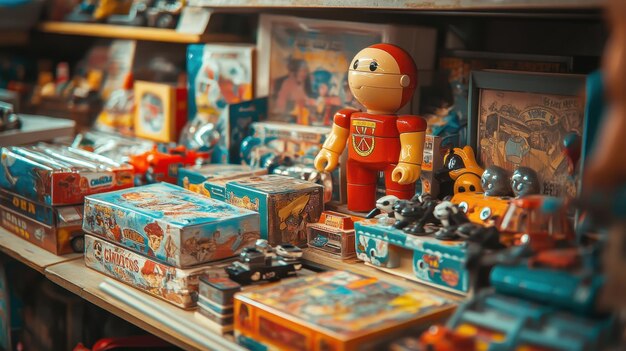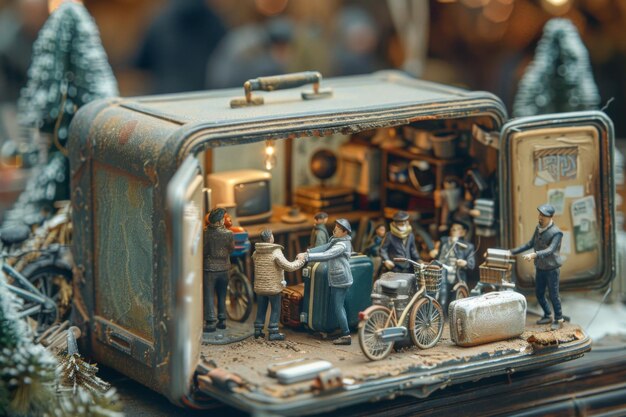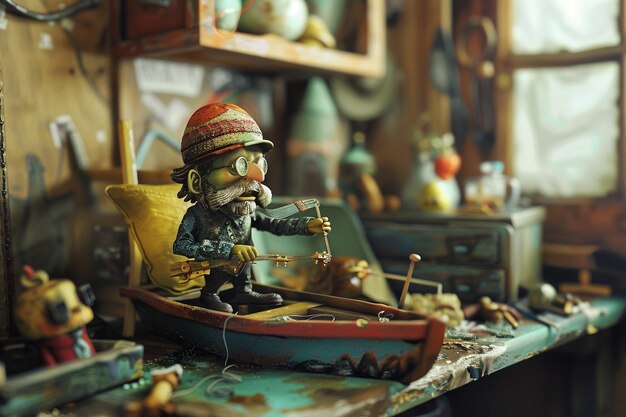Cold War Classics Reborn: Revitalizing Vintage Toys and Games
Cold War Classics Reborn: Revitalizing Vintage Toys and Games
During the Cold War era, a unique collection of toys and games emerged that reflected the societal climate of the time. These classic items have since been rediscovered and revitalized by modern enthusiasts, becoming sought-after gems for collectors and nostalgic buyers. In this article, we’ll delve into the captivating world of Cold War classics, focusing on the stories behind these vintage treasures and the ways they’re being brought back to life.
The Origins of Cold War Toys and Games
In the late 1940s and 1950s, as tensions between the United States and the Soviet Union escalated, toy manufacturers began producing playthings that mirrored the political landscape. The result was a diverse range of Cold War-inspired items, including board games, action figures, and even educational toys. These products often contained subtle or overt political messages and were designed to engage children in the geopolitical issues of the day.
Board Games: A Diplomatic Pastime
Board games were among the most popular Cold War-themed toys, offering families an entertaining and educational way to discuss global events. Some games featured actual world maps with territories representing various countries or ideologies. Others allowed players to take on the roles of diplomats, military leaders, or even spies, fostering critical thinking skills and promoting strategic planning.
Classic Examples: Risk, Strategy, and Diplomacy
Risk, first published in 1957, is a prime example of a Cold War-era board game. Players wage wars against one another and conquer territories, aiming to control the entire world. This game’s global scope and its emphasis on strategic planning make it a timeless classic.
Stratego, which debuted in 1959, is another beloved Cold War board game. In this game, players hide their pieces and try to outmaneuver one another on a battlefield, using cunning tactics to capture their opponents’ flag. Its emphasis on deception, strategy, and diplomacy continues to captivate players today.
A Modern Revival
Thanks to the renewed interest in Cold War history and nostalgia for vintage toys, many classic games have been reissued or given new life through modern adaptations. For instance, WizKids, the company behind the popular HeroClix collectible miniatures game, has released a line of Cold War-themed figures. These detailed miniatures allow players to recreate iconic battles and engage in strategic combat, providing an immersive experience that blends history and gaming.
Action Figures: Heroes and Villains
Action figures
represented another significant segment of Cold War-era toys. These collectible figurines, often featuring soldiers, politicians, or even fictional characters, offered children a way to engage with the heroes and villains of their time. Some action figures were designed to be educational, while others served purely entertainment purposes.
Notable Figures: GI Joe and The Communists
GI Joe
is one of the most iconic Cold War action figure lines. Debuting in 1964, these 12-inch figurines represented various military branches and roles, providing kids with a diverse range of characters to collect. GI Joe figures were designed to promote teamwork and patriotism through imaginative play.
The Communists, on the other hand, were a lesser-known but intriguing line of Cold War action figures produced by Marx Toys. These figurines, which included soldiers and political leaders from the Soviet Union and other Communist countries, were intended to serve as a counterpoint to GI Joe. Despite their controversial origins, these figures have become collectors’ items.
A Collectible Renaissance
The current fascination with vintage toys and games has led to a surge in interest for Cold War action figures. Collectors scour auctions, antique shops, and online marketplaces to acquire these rare pieces, often investing significant time and resources into their collections.
Educational Toys: Learning in the Time of Tension
Educational toys
were an essential part of Cold War-era playthings, as they provided children with a fun and interactive way to learn about the world around them. Many educational toys focused on geography, history, and science, fostering important skills and knowledge.
Exemplary Educational Toys: Globetrotter and World Wide Web
Globetrotter, an educational globe produced by Milton Bradley in 1950, was a prime example of this genre. This interactive toy allowed children to learn about various countries and their locations while spinning the globe and listening to recorded facts.
World Wide Web, a line of educational toys produced by Ideal in the late 1950s, offered kids the chance to explore science concepts through hands-on experimentation. These toys included sets focused on subjects like electricity, magnetism, and chemistry, providing children with an engaging way to learn about the natural world.
A Timeless Impact
Despite the passage of decades, the influence of Cold War-era toys and games remains evident. These collectibles serve as a fascinating reminder of a bygone era, offering insights into the societal climate and cultural values of the time. Moreover, their educational and entertainment value continues to resonate with collectors, historians, and those who seek a deeper understanding of our collective past.
In Conclusion
As we rediscover and revitalize the vintage toys and games of the Cold War era, we not only honor their rich history but also inspire new generations to engage with these captivating pieces. The stories behind these classic items offer valuable lessons about the past, providing us with a unique perspective on the world and its ever-evolving landscape.

Revitalizing Vintage Cold War Toys and Games: Nostalgia, Education, and Creative Expression
During the Cold War era (1947-1991), geopolitical tensions between the United States and the Soviet Union shaped the global political landscape. This period, marked by ideological conflicts and proxy wars, had a profound impact on popular culture. One might be surprised to learn that toys and games played an essential role in shaping the collective consciousness of the time.
Historical Context
In a world where nuclear war loomed, families sought comfort and normalcy through play. Vintage toys and games reflected the era’s mood, with many depicting military themes or espionage scenarios.
Military Toys
Children’s toy soldiers, war planes, and naval fleets were common. These toys often came in bright, bold colors and meticulous detail. Their design not only appealed to children but also served as an educational tool, helping them understand the military forces of their respective nations.
Espionage Games
Board games like “Clue”, which was initially titled ““Detective”,” and card games, such as “Spy Ring,” allowed children to engage in espionage-themed activities, subtly fueling their imaginations during the Cold War era.
Significance in Today’s World
As time passes, these vintage Cold War toys and games have become precious relics.
Nostalgia and Collectibility
Many collectors seek out these items, not only for their historical value but also for the sense of nostalgia they evoke. Reviving these pieces offers a connection to a bygone era, providing a unique perspective on history.
Educational Value and Historical Preservation
The collection and study of vintage Cold War toys and games serve as an essential reminder of the historical context that shaped them. This educational value is crucial for preserving history and ensuring future generations understand the significance of this era.
Creative Inspiration and Artistic Expression
Moreover, these vintage items offer inspiration for modern artists and designers. Their revival allows contemporary creators to draw influence from the past, contributing to new and innovative works in various mediums.
Chapter 1: The Origins of Cold War Toys and Games
This chapter explores the emergence of Cold War toys and games during the early years of the Cold War era. It delves into their historical context, including the social and political climate of the time, and how these items impacted popular culture.
Chapter 2: The Golden Age of Cold War Toys and Games
This chapter examines the peak popularity and cultural significance of Cold War toys and games during the 1960s and early 1970s. It discusses various examples, including military toys, espionage-themed games, and their impact on society during this period.
Chapter 3: The Aftermath and Revival of Cold War Toys and Games
This final chapter covers the decline of Cold War toys and games following the end of the Cold War, as well as their recent revival. It explores how collectors, artists, and designers have rediscovered these items, and how they continue to influence modern culture.

Chapter 1: Origins of Cold War Toys and Games
During World War II, children’s imaginations were captured by military-themed toys and games. These included link, link, and toy planes, which allowed them to engage with the world around them in a playful but meaningful way. As tensions between the United States and Soviet Union began to rise in the late 1940s, these toys and games evolved to reflect the new geopolitical climate.
Military-themed Toys during World War II
Military-themed toys and games from the WWII era were a popular means of entertainment for children, offering them an opportunity to learn about the world around them while fostering creativity and problem-solving skills. Among these toys were tin soldiers, which could be arranged in intricate battle formations, toy planes that could be flown around rooms, and model trains, which allowed children to build and operate their own miniature railways.
Emergence of Cold War Toys and Games in the Late 1940s
In the late 1940s, as the world adjusted to the aftermath of World War II and the emergence of the Cold War, board games that simulated strategic decision-making became increasingly popular. Some of the most iconic examples include link, which required players to conquer territories and build armies; link, a game of property trading and wealth accumulation; and link, a classic two-player game of military strategy.
Board Games: Strategic Decision-making
Board games offered an engaging way for children to learn about the complexities of geopolitics and strategic decision-making during a time when global tensions were on the rise. These games often required players to make calculated moves, build resources, and navigate intricate political landscapes, helping to foster critical thinking skills and a deeper understanding of the world around them.
Action Figures: Political Leaders and Military Personnel
Along with board games, the 1940s also saw the emergence of action figures representing political leaders and military personnel. These collectible figurines allowed children to engage with historical and cultural icons in a more tangible way, fostering a greater appreciation for history and the people who shaped it. Some notable examples include presidential action figures, GI Joe, and Soviet counterparts, which offered children a unique window into the world of politics and military strategy.
Cold War-inspired Media and Merchandise: Comics, Cartoons, Movies, Space Exploration, and Science Fiction
As the Cold War continued to unfold, it also inspired a wave of media and merchandise that captured children’s imaginations. From comics and cartoons that depicted heroic figures standing up to the Soviet threat, to movies like “Star Wars,” which offered a thrilling escape from reality, and even space exploration and science fiction stories that explored the possibilities of a technological future, these forms of entertainment provided children with a rich tapestry of experiences that reflected and shaped their understanding of the world around them.

